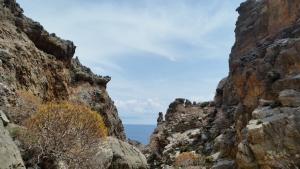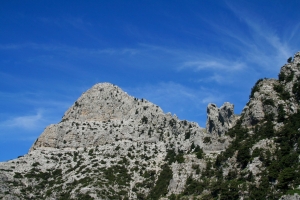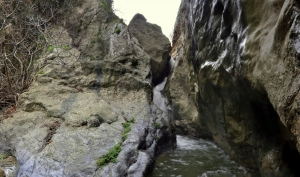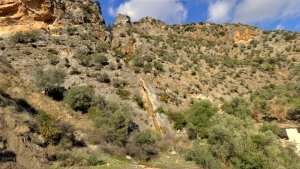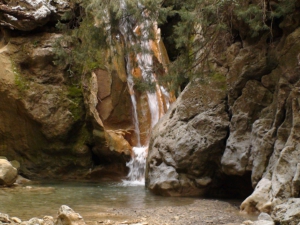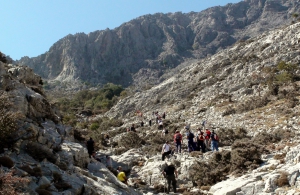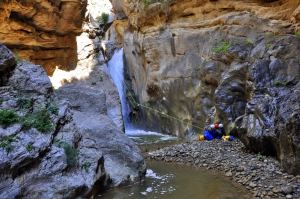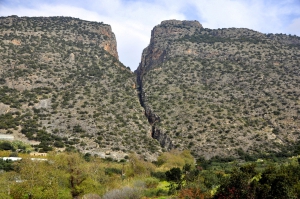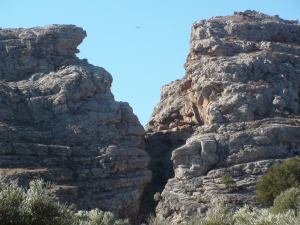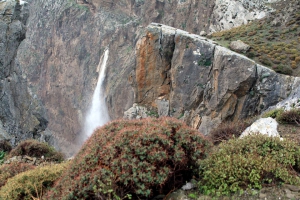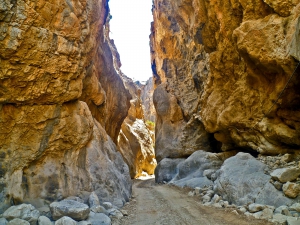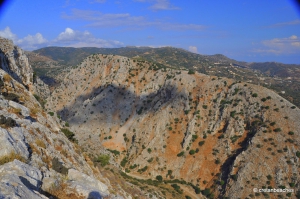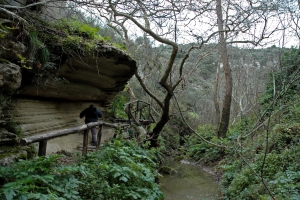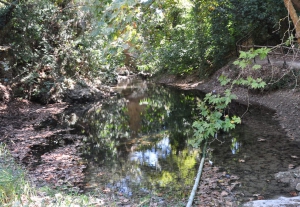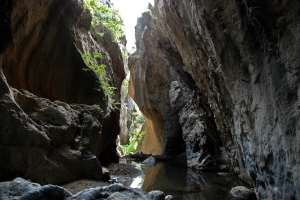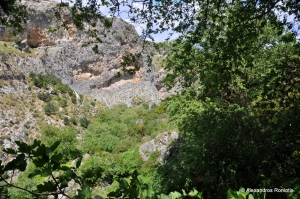Petrigiari is a small and wild gorge located parallel to the wild gorge of Kakoperatos, at the south coastline of Central Crete. The canyon is only accessible with technical (canyoning) equipment) with the maximum rapel being about 15m. The gorge ends at an amazing tiny pebbly beach with caves and crystal clear deep blue water.
The gorge Koudoumas starts at an altitude of 1000m near the base of the highest peak of Asterousia Range, Kofinas, and ends on the beach of Koudoumas Monastery.
Adjacent and parallel to the current highway linking Heraklion to Messara plane, between the villages Prinias and Avgeniki, a beautiful canyon is formed. Its descent requires the use of canyoning equipment, as it forms some steep descents.
On the southeast side of Mount Sanida, near the village Skourvoula, a small but very wild gorge is formed called Rizopetro. The gorge ends near Faneromeni dam after a very impressive 60m high waterfall, having water only after heavy rainfalls.
The gorge of Agios Nikolaos, Gafaris or Rouvas is bounded by the peaks of Ambelakia from east and Samari from west. This is the most important gorge of Psiloritis and central Crete and took its name from the homonymous Byzantine church in the south entrance. This is an ecosystem with rich flora and fauna, smaller canyons and interesting geological formations and cliffs of rare beauty.
East of Voriza village, at the foot of Psiloritis, starts an arid canyon with holly trees that leads to the plateau of Nida Plateau and the cave Ideon Antron. The gorge is very steep at the beginning with small waterfalls coming from the brecciated steep limestone cliffs.
Portela Gorge is located at the south of the prefecture of Iraklion; the canyon starts from Hondros village and its exit is in Keratokambos. It is one of the most dangerous canyons in Greece.
There are several places in Crete that are beautiful, but only a few of them can be described as winders of nature. A place that is a real wonder of nature is the gorge of Arvi that tears Arvion Mount in two, over which the shrine of Zeus Arveios was sited.
Kavousi Canyon is located near Keratokambos (near Ano Viannos, south Heraklion) in Dikti Mountain. The total length is 1km and the altitudinal difference between entrance and exit is 170m.
The gorge of Ambas is located 53km south of Heraklion, in Asterousia Mountains. Starting from the small plateau formed near the village Paranymfi (710m altitude), it ends at the beach of Treis Ekklisies. This is a large (4km long) and beautiful canyon with many narrow passages, which is accessible only by experienced canyoners.
The gorge of Trypiti is formed at the range Asterousia, to the south of the village Vassiliki. The length of the canyon reaches 4 km and a beautiful pebble beach is formed at its exit. The beach is reached though a dirt road that runs high along the eastern side of the canyon for several kilometers before reaching its riverbed, just before the exit to the sea.
Agiofarago Gorge (meaning Gorge of Saints) is located in south of Odigitria Monastery and has been shaped near the beds of two streams. The first stream starts north - northeast of Gyalomonochoro and the other starts northeast of the Odigitria. The two streams meet, near St Kiriaki and after following a relatively smooth path, west and south of Church St. Kiriaki, it arrives in Porofarango, where the main gorge of Agiofaraggouo starts and ends at the Libyan Sea, at a small but amazing beach.
The gorge Almyros is located in Linoperamata, close to Heraklion, between Keri and Kastrokefala. Almiros Gorge is the nearest gorge to Heraklion, a natural oasis close to the bustling city, formed between the hills of Keri and Kastrokefala.
The canyon Aposelemis exits at the settlement Agrianá (or Adrianna as its inhabitants call it). It is the longest and most important geological canyon in the northern part of the prefecture of Heraklion.
The gorge of Roza is an offshoot of the gorge of Ambelos. It starts from a point near the rural road that crosses the gorge of Ambelos and has east-southeast direction, leading to Kera.
Kounaviano canyon is the richest (in vegetation) gorge in the prefecture of Heraklion, a real oasis in the center of the province Pediada. The name comes from the village Kounavi. It is a tributary of the river Karteros and runs parallel to Astrakiano gorge, with which in merges at position Kaki Rachi by Skalani and then form the Gorge of Karteros.
Astrakiano and Kounaviano canyons are two lush green gorges by Heraklion that merge near the village Skalani and carry on their united course till Karteros. The total length of the two canyons is about 21 km.
The unknown canyon of Venerato is located 17km south of Heraklion, just next to the village Venerato and Paliani Monastery. The deep part of the gorge is very short in length (about 500m), but its beauty does not leave the visitor unaffected, although it is badly infected by human activities.
West of the village Ano Asites the river that initially is the gorge of Saint Haralabos and then crosses the village soon turns into a deep and spectacular gorge, the gorge of St. Anthony.










